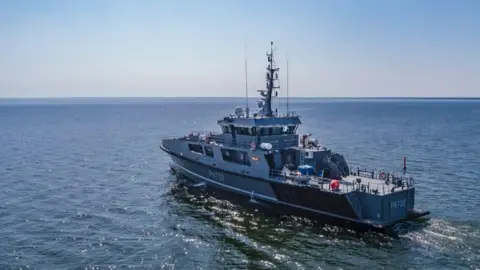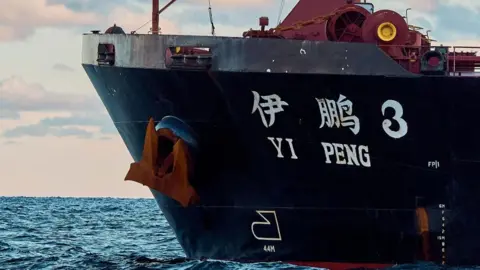 Estonian military
Estonian militaryNATO said it would strengthen its military presence in the Baltic Sea, and Estonia sent a patrol ship to protect the Estlink1 marine power cable, after Russia was accused of sabotaging the main power link in the Gulf of Finland.
A ship called Eagle S was suspected of damaging the Estlink 2 cable, and a Finnish Coast Guard crew boarded the oil tanker and steered it into Finnish waters.
The EU said the Eagle S was part of Russia’s “shadow fleet” and that the failure of the submarine cable was just that “The latest in a series of suspected attacks on critical infrastructure.”.
Estonian Defense Minister Hannu Pefkur said the Raju had set sail early on Friday, and it was believed Finland would join the operation to protect the remaining cable.
He told Estonian public radio that Raju’s mission is “to make sure that nothing happens there and that our important contacts with Finland remain effective.”
NATO Secretary General Mark Rutte said on social media that he spoke with Finnish President Alexander Stubb, adding that… NATO will work to strengthen its presence in the Baltic region.
Finland and Estonia are members of NATO, and Estonian Prime Minister Kristin Michel told public television that, if necessary, they would resort to Article 4 of the NATO treaty, which includes consultation if any member state feels threatened.
The British News Agency quoted him as saying: “We would like to obtain reinforcements from NATO in the form of a fleet to act as a deterrent force.”
Estonia’s power supply has declined dramatically following the shutdown of the 170-kilometre (105-mile) Estlink 2 cable.
In its initial assessment on Thursday, Finnish company Fingrid said cable repairs could continue until the end of July 2025.
The damage to Estlink 2 is the third accident in just over a month in the Baltic Sea.
Last month, two data cables were cut: the Arilion cable between the Swedish island of Gotland and Lithuania on November 17, and then the C-Lion 1 cable between the Finnish capital Helsinki and the German port of Rostock was damaged.
The Chinese vessel, Yi Peng 3, is suspected of dragging its anchor over cables in a separate act of Russian sabotage.
 EPA-EFE/REX/Shutterstock
EPA-EFE/REX/ShutterstockIn October 2023, another Chinese ship tore up an undersea gas pipeline between Finland and Estonia.
The tankers Yi Peng 3 and Eagle S are suspected to be part of the so-called shadow fleet of oil tankers used by Russia to evade Western sanctions imposed since the massive invasion of Ukraine.
The European Union said it was working on taking measures, including imposing sanctions, to target “the Russian shadow fleet that threatens security and the environment.”
After several weeks of anchoring in the Kattegat Strait between Sweden and Denmark, the authorities of Sweden, Denmark, Germany and Finland eventually arrested the Chinese tanker, but it then set sail last week.
By contrast, Finnish authorities said they boarded the Cook Islands-registered vessel Eagle S in the early hours of Thursday and escorted it toward the Finnish coast off Porkala, across the Gulf of Finland from Tallinn.
“Our patrol ship traveled to the area and was able to visually determine that the ship’s anchor was missing,” Markku Hasinen, deputy chief of the Finnish Border Guard, said at a press conference.
The Estonian Prime Minister sought to reassure Estonians on Thursday that they will continue to have safe energy supplies.
He told reporters that the two main energy companies, Ellering and Esti Energia, have several reserve and redundant power plants.
But he added that it was impossible to protect every square meter of the seabed at all times.
https://ichef.bbci.co.uk/news/1024/branded_news/b57d/live/e0ef6910-c432-11ef-895e-b1d759fc74a3.jpg

